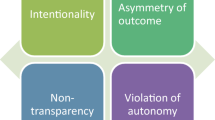Abstract
Information is defined through the introduced concepts of an information object and an information interaction, in which the change in the state of objects-originals involves a change in their images. Information is a macro form that emerges in a nonequilibrium medium and has a dual nature as an object and as a reality. Knowledge is defined as information that is reduced to the superposition of possible states of the information object in different individual domains. Information fulfills communication functions, interactions in an individual domain, and its own functions that actualize its own validity. In terms of the mechanism of interaction, information, being a structured and not atomic object, should have “interface” elements that join it with communication objects.
Similar content being viewed by others
References
Meintzer, K., Complex Systemic Thinking: Matter, Mind, Humanity. New Synthesis, M.: Librok, 2009.
Golitsyna, O.L., Maksimov, N.V., and Popov, I.I., Informatsionnyie sistemy: ucheb. posoviye (Information Systems: Handbook), M.: Forum, 2007.
Khaken, G. Informatsiya i samoorganizatsiya. Makroskopic podkhod k slozhnym sistemam (Macroscopic Approach to Complex Systems), M.: KomKniga, 2005.
Knyazeva, N.N., and Kurdyumov, S.P., Osnovaniya sinergetiki (Basics of Synergetics), M.: KomKniga, 2006.
Prigozhin, I. and Stengers, I., Vremya, khaos, kvant (Time, Chaos, Quantum), M.: Editorial URSS, 2003.
Chernavskii, D.S., Sinergetika i informatsiya (dinamicheskays teoriya informatsii) (Sinergetics and Information: Dynamic Theory of Information), M.: Editorial URSS, 2004.
Vernadskii, V.I., Biosfera i ionosfera (Biosphere and Noosphere), M.: Airis-press, 2008.
Gladkikh, N.G., Dynamic Information Processes, in Sistemy i sredstva informatiki, no. 11, 2001, pp. 341–362.
Grinchenko, S.N., The Definition of Concepts “Informatics” and “Informatization,” Sistemy i sredstva informatiki, no. 11, 2001, pp. 363–375.
Shreider, Yu.A., Information Model of Complementarity Principle, Semiotika i informatika, no. 33, M.: VINITI, 1993, pp. 101–105 (reprinted in NTI, ser. 2, no. 9, pp. 7–9).
Novoselov, M.M. Abstraktsiya v labirintakh poznaniya (logicheskii analiz) (Abstraction in Labyrinths of Cognition: Logical Analysis), M.: Ideya-Press, 2005.
Vasina, Ye.N., Golitsyna, O.L, and Maksimov, N.V., Architecture of AISS: Technology and Means of Search in Documental Information Resources, NTI, Ser. 1, no. 5, 2007, pp. 1–14.
Additional information
Original Russian Text © N.V. Maksimov, 2010, published in Nauchno-Tekhnicheskaya Informatsiya, Seriya 2, 2010, No. 7, pp. 1–10.
About this article
Cite this article
Maksimov, N.V. Information and knowledge: Nature and the conceptual model. Autom. Doc. Math. Linguist. 44, 177–186 (2010). https://doi.org/10.3103/S0005105510040011
Received:
Published:
Issue Date:
DOI: https://doi.org/10.3103/S0005105510040011




